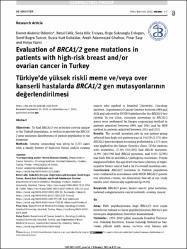| dc.contributor.author | Akdeniz Ödemiş, Demet | en_US |
| dc.contributor.author | Çelik, Betül | en_US |
| dc.contributor.author | Kılıç Erciyas, Seda | en_US |
| dc.contributor.author | Şükrüoğlu Erdoğan, Özge | en_US |
| dc.contributor.author | Tuncer, Şeref Buğra | en_US |
| dc.contributor.author | Kurt Gültaşlar, Büşra | en_US |
| dc.contributor.author | Adamnejad Ghafour, Arash | en_US |
| dc.contributor.author | Saip, Pınar | en_US |
| dc.contributor.author | Yazıcı, Hülya | en_US |
| dc.date.accessioned | 2022-02-17T12:51:02Z | |
| dc.date.available | 2022-02-17T12:51:02Z | |
| dc.date.issued | 2022 | en_US |
| dc.identifier.citation | Akdeniz Odemis, Demet, Celik, Betul, Kilic Erciyas, Seda, Sukruoglu Erdogan, Ozge, Tuncer, Seref Bugra, Kurt Gultaslar, Busra, Adamnejad Ghafour, Arash, Saip, Pinar and Yazici, Hulya. "Evaluation of BRCA1/2 gene mutations in patients with high-risk breast and/or ovarian cancer in Turkey" Turkish Journal of Biochemistry, vol. , no. , 2022. | en_US |
| dc.identifier.uri | https://doi.org/10.1515/tjb-2021-0209 | |
| dc.identifier.uri | https://hdl.handle.net/20.500.12294/2972 | |
| dc.description.abstract | Objectives To find BRCA1/2 test selection criteria unique to the Turkish population, as well as to provide the BRCA1/2 gene mutation distributions of patient population to the literature. Methods Genetic counseling was given to 2,373 cases with a family history of high-risk breast and/or ovarian cancer who applied to Istanbul University, Oncology Institute, Department of Cancer Genetics between 1994 and 2021 and selected by NCCN Guidelines for the BRCA1/2 test criteria. In our clinic, mutation screenings in BRCA1/2 genes were performed by Sanger sequencing method in patients admitted between 1994 and 2014 and by NGS method in patients admitted between 2015 and 2021. Results The overall mutation rate in our patient group selected from high-risk patients was 16.5% (391/2,373) after BRCA1/2 gene mutation screening performed in 2,373 cases who applied to the Cancer Genetics clinic. Of the patients with mutations, 57.5% (225/391) had BRCA1 mutation, 41.9% (164/391) had BRCA2 mutation, and 0.6% (2/391) had both BRCA1 and BRCA2 pathogenic mutations. People diagnosed before the age of 60 who have a history of triple-negative breast cancer had a 28.5% overall mutation rate. Conclusions BRCA1/2 mutation in Turkish population were evaluated in accordance with NCCN BRCA1/2 genetic test selection criteria; we discovered that all of our study results were statistically significant (p<0.05). | en_US |
| dc.language.iso | eng | en_US |
| dc.publisher | De Gruyter | en_US |
| dc.relation.ispartof | Turkish Journal of Biochemistry-Turk Biyokimya | en_US |
| dc.identifier.doi | 10.1515/tjb-2021-0209 | en_US |
| dc.identifier.doi | 10.1515/tjb-2021-0209 | |
| dc.rights | info:eu-repo/semantics/openAccess | en_US |
| dc.rights | Attribution-NoDerivs 3.0 United States | * |
| dc.rights.uri | http://creativecommons.org/licenses/by-nd/3.0/us/ | * |
| dc.subject | BRCA1 | en_US |
| dc.subject | 2 Genes | en_US |
| dc.subject | Breast Cancer | en_US |
| dc.subject | Gene Mutation | en_US |
| dc.subject | Comprehensive Cancer Network | en_US |
| dc.title | Evaluation of BRCA1/2 Gene Mutations in Patients With High-Risk Breast and/or Ovarian Cancer in Turkey | en_US |
| dc.type | article | en_US |
| dc.department | Tıp Fakültesi, Temel Tıp Bilimleri Bölümü | en_US |
| dc.authorid | 0000-0002-8919-0482 | en_US |
| dc.identifier.startpage | 1 | en_US |
| dc.identifier.endpage | 17 | en_US |
| dc.relation.publicationcategory | Makale - Uluslararası Hakemli Dergi - Kurum Öğretim Elemanı | en_US |




















